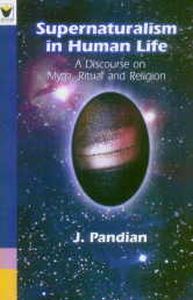
Contents: Preface. I. Introduction: 1. Objectives and scope of this book: i). Goals of this study. ii). Mytholiminal rationality and supernaturalism. iii). The semiotics of supernaturalism. iv). Prophetism and transcultural supernaturalism. v). Organization of this book. 2. Religion, magic and supernaturalism: i). The Roman-Latin concept of Religio. ii). Definitions of religion. iii). Disciplinary domains in the study of religion. iv). Explanation and interpretation in the study of supernaturalism. v). The future of supernaturalism. II. Theories of supernaturalism: 3. Psychological theories of supernaturalism: i). Projection, anthropomorphism and supernaturalism. ii). The primitive mind and supernaturalism. iii). Projection, neurosis and the quest for protection. iv). Psychosocial theories of supernaturalism. 4. Sociological theories of supernaturalism: i). The social function of supernaturalism. ii). Theophagy and tribal identity. iii). Apotheosis and the worship of society. iv). Sociological racism. v). Social structure and supernaturalism. vi). Historical materialism and supernaturalism. 5. Ecological theories of supernaturalism: i). Culture and environment. ii). Cannibalism, the sacred cow and the polluted pig. iii). The sacred pig. iv). The quest for an ecological millennium. 6. Symbological theories of supernaturalism: i). Phenomenological and hermeneutic studies of supernaturalism. ii). Supernatural symbols and economic action. iii). Supernatural symbols and self-integration. iv). Supernatural symbols and cultural coherence. v). Supernatural symbols of Cosmos. vi). Symbols of supernatural autonomy. vii). Sacred symbols of supernaturalism. viii). Symbols of the liminal self. ix). The supernatural boundaries of self. III. Supernaturalism in myth and ritual: 7. Mythic beliefs and narratives of supernaturalism: i). Myth, mythic beliefs, mythic narratives and mythology. ii). The study of mythic narratives. iii). Mythic narratives of creation. iv). Mythic narratives of after-life. 8. Mythic symbols of supernatural powers and supernatural beings: i). The distinction between supernatural powers and supernatural beings. ii). Mythical symbols of supernatural power. iii). Mythic symbols of supernatural beings. iv). Mythic symbols of Goddesses. v). The conceptual category of the Mother Goddess in a South Indian village. vi). Totems and Guardian spirits. 9. Ritual communication with supernatural beings and ritual acquisition of supernatural power: i). The nature of ritual. ii). The mythology of rituals. iii). Ritual and liminality. iv). The universality of ritual inversion. v). Ritual inversions in North American Indian Societies. vi). Ritual inversion and supernaturalism. 10. Supernaturalism and the rituals of identity-transformation and social integration: i). Supernaturalization of identity-transformation. ii). Supernaturalization of male solidarity. iii). Supernaturalization of the body. iv). Supernaturalization of death. v). Supernaturalization of social solidarity. 11. Supernaturalism and the rituals of witchcraft, divination and healing: i). Supernatural worldview of witchcraft, divination and healing. ii). Rituals of divination: supernaturalization of knowledge. iii). Rituals of witchcraft and sorcery: Supernaturalization of causation. iv). Healing rituals: supernaturalization of health. IV. Icons of supernaturalism and the semiotics of prophetism: 12. Iconic integration of supernaturalism and cultural themes: i). Supernaturalism and iconicity. ii). Iconicity and prophetism. iii). Cultural icons of Hindu supernaturalism. iv). Cultural icons of Islamic supernaturalism. v). Cultural icons of Catholic supernaturalism. 13. Shamans, priests and prophets: i). The professionalization of supernatural mediation. ii). Discourse on the Shaman and Shamanism. iii). The typological characteristics of Shamans and Shamanism. iv). Shamanism in the Hindu tradition. v). The "Celestial journey" of the Shaman. vi). Priesthood and social hierarchy. vii). Hinduism and Brahmanical priesthood. viii). Greco-Roman conceptions of priesthood and patriarchy. ix). The semiotics of prophetism and prophetic supernaturalism. 14. Prophetic supernaturalism: i). Prophetism and the transformation of the supernatural-cultural order. ii). Theories of prophetic supernaturalism. iii). The Seneca prophetic movement. iv). Prophetism and millenarianism. v). Prophetic supernaturalism and communitas. vi). Cults and prophetic supernaturalism. vii). A classification of prophetic supernaturalism. 15. Transcultural supernaturalism and globalization: i). The structure and function of transcultural prophetism. ii). Transcultural prophetism and transcultural supernaturalism. V. Conclusion: 16. Globalization, modernity and pluralistic supernaturalism.
"This provocative book will be of interest to scholars, students and the lay public. Drawing upon a lifetime of research into the human foundations of supernatural beliefs in India, the United States and other parts of the world, Dr. Pandian examines a range of important psychological, sociological, ecological and symbological theories of supernaturalism, exploring the origin, function and relevance of supernaturalism in human life. He locates the foundation of supernaturalism in myth and ritual and theorizes that myth and ritual are rooted in "mytholiminal" rationality, which is an evolutionary adaptation concerned with the crafting of coherence, transcendence and meaning in human life.
"Dr. Pandian challenges some of the scholarly assumptions about myth, ritual and religion, offers an analysis of the icons and embodiments of supernaturalism, and provides a comprehensive discourse on the role of prophets, prophetism, and the nature of prophetic movements and transcultural supernaturalism. He suggests that it is important to make a distinction between pluralistic supernaturalism and ethnocentric prophetic supernaturalism in order to understand the implications of these two types of supernaturalism for the survival of humankind and the world." (jacket)
Dr. J. Pandian is Professor of Anthropology at California State University, Fullerton. His previous book was The Making of India and the Indian Traditions.